 GC inherited a souvenir blue colored late 19th century glass with the place name “Bad Elster” inscribed in gold. I can guess this little vessel came as a memento from the magnificent bubbling springs located in the historic Spa town of Bad Elster in Saxony, Germany. Folks have drank Bad Elster spring waters for health reasons as early as 1531. Perhaps a wealthy visitor drank such curative waters from this very glass, and “borrowed’ it to take home. Then he eased his conscience in a relaxing soak in the nearby mineral rich mud baths.
GC inherited a souvenir blue colored late 19th century glass with the place name “Bad Elster” inscribed in gold. I can guess this little vessel came as a memento from the magnificent bubbling springs located in the historic Spa town of Bad Elster in Saxony, Germany. Folks have drank Bad Elster spring waters for health reasons as early as 1531. Perhaps a wealthy visitor drank such curative waters from this very glass, and “borrowed’ it to take home. Then he eased his conscience in a relaxing soak in the nearby mineral rich mud baths.
I surmise this hand blown glass was made for one of two historic Spa Hotels still marveled at today. The tradition of ‘showing oneself’ at a natural spring spa goes back to Roman times, and was perfected in the 18th century at such places like Bad Elster and the historic town of Bath, England. The 19th century elite considered such a natural landscape feature as a mineral spring a tremendous tourist draw. Beautiful custom designed Spa architecture sprang up around such delightful watering holes. The upper classes came for massages, pampering, and to be ‘seen.” A health treatment in an elegant Spa-Hotel became an extremely social occasion, and included musical events, promenades, much attention to one’s attire and deportment, and much outdoor flirtation.
I wager to bet this little glass originated at one of two such elegant Spa hotels located in Bad Elster in the late 19th century, perhaps the Royal Kurhaus, or the King Albert Spa (1888-1890). I favor the origin of the King Albert Spa, because this glass, with its sloping lines and naturalistic floral enameling, evokes the Art Nouveau style of the architecture. The Royal Kurhaus was more of a classical building, in the Renaissance Revival style. Think Italian Renaissance palace architecture. Guests entertained as befitted the grand architecture of the stately stone two-story with its outstretched promenade pavilions.
The little glass holds secrets of delightful mineral baths, natural jet baths, and water-drinking cures, not to mention leisurely strolls to the nearby Temple of Flora, a garden celebrating springtime that boarded the Spa’s private boating lake. This era in Germany was one of “Classical Revival” in the fine art of the period, which no doubt graced the walls of such Spa buildings. We see goddesses, a good excuse to paint naked women, floral bouquets, mythical heroes, and romantic idylls with 17th and 18th century courtiers.
The fine art of the late 19th century in Germany, a candy-box affair, tells us a lot about the lives of the wealthy, and also tells us the ‘have-nots’ really suffered. Not long after this era German military focused on the highborn solider of the day, with sparking buttons on an immaculate uniform. We see the disaster caused by this mid-set of the Uber-mensch in WWI. However, somebody first used, and stole, this little glass during the golden age of the upper class who considered the health spa and its grand architecture the theater of the day. This little glass has a big story to tell.
Today we can only imagine the elegance, refinement, and expense of such vacations. This kind of a health cure existed for the very wealthy who owned the clothes to be seen in. The common local folk relied, in the case of Bad Elster, on the springs placed near the town square.
The late 19th century saw the craze for the souvenir glass, a tradition developed for giving such mementos as gifts, and began by memorializing a place-name on a little vessel.
By the American Centennial Celebration of 1876 artisans in souvenir booths inscribed a glass with a loved-ones name and the date of such a fair. I see many of these in a deep ruby red color with an etched name of a person cut to the clear glass through the color. Fair souvenirs such as these ruby glasses included tumblers and handled mugs, and shapes in glass, too, like the “Liberty Bell” souvenir. The tradition of the souvenir-drinking vessel predates the custom of “Carnival Glass” (1905) that was NOT hand blown, but pressed glass.
The value of GC’s souvenir 19th century glass from Bad Elster is minimal at $20, but the story is priceless.